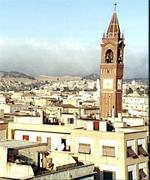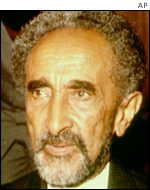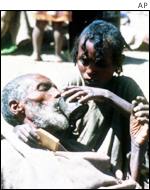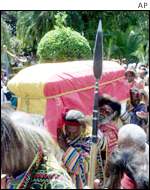A chronology of key events:
600 - Arabs introduce Islam to coastal areas.
1500s - Ottoman Empire annexes Eritrea.
1890 - Eritrea becomes an Italian colony.
1941 - British forces occupy Eritrea.
 Asmara skyline
|
1952 - UN decides to make Eritrea a federal component of Ethiopia.
1958 - Eritrean Liberation Front formed.
Independence struggle
1962 - Ethiopia annexes Eritrea, turning it into a province; war of independence begins.
1970 - Leftist faction of the Eritrean Liberation Front splits to form the Eritrean People's Liberation Front.
1974 - Ethiopian Emperor Haile Selassie overthrown in a coup led by Mengistu Haile Mariam.
1977-78 - Soviet advisers and Cuban troops help Ethiopian forces reverse significant advances made by Eritrean guerrillas.
1990 - Eritrean People's Liberation Front captures the Eritrean port of Massawa.
1991 - Eritrean People's Liberation Front captures the Eritrean capital, Asmara and forms a provisional government; the United Nations sets a date for a referendum on Eritrean independence with Ethiopian backing.
1993 - Eritreans almost unanimously vote for independence; Eritrea becomes independent and joins the United Nations.
Post-independence war
1995 - Eritrean troops invade the Yemeni-held Hanish islands at the mouth of the Red Sea.
1998 - International arbitration panel awards the Greater Hanish island to Yemen and divides other smaller islands between the two countries; border dispute between Eritrea and Ethiopia escalates into large-scale fighting.
 Civilians fleeing Ethiopian bombardment
|
2000 May - Ethiopia captures the strategic Eritrean town of Barentu.
2000 June - Eritrea and Ethiopia sign a ceasefire agreement which calls for a United Nations force to monitor their compliance and to supervise the withdrawal of Ethiopian troops from Eritrean territory.
2000 December - Eritrea and Ethiopia sign a peace agreement in Algeria establishing commissions to mark the border, exchange prisoners, return displaced people and hear compensation claims.
2001 6 February - Eritrea accepts United Nations plans for a temporary demilitarised zone along its border with neighbouring Ethiopia.
2001 24 February - Ethiopia says it has completed its troop withdrawal from Eritrea in accordance with a United Nations-sponsored agreement to end the border war.
2001 April - Eritrea announces that its forces have pulled out of the border zone with Ethiopia - a key provision of the peace agreement signed between the two countries.
2001 21 May - Eritrea and Ethiopia agree on a UN-proposed mediator to try to demarcate their disputed border.
2nd Century AD - Semitic people from the Arabian peninsula establish the kingdom of Aksum.
4th Century - Coptic Christianity introduced from Egypt.
1530-31 - Muslim leader Ahmad Gran conquers much of Ethiopia.
Foreign interference
1818-68 - Lij Kasa conquers Amhara, Gojjam, Tigray and Shoa.
1855 - Kasa becomes Emperor Tewodros II.
1868 - Tewodros defeated by a British expeditionary force and commits suicide to avoid capture.
1872 - Tigrayan chieftain becomes Yohannes IV.
1889 - Yohannes IV killed while fighting Mahdist forces and is succeeded by the king of Shoa, who becomes Emperor Menelik II.
1889 - Menelik signs a bilateral friendship treaty with Italy at Wuchale which Italy interprets as giving it a protectorate over Ethiopia.
1889 - Addis Ababa becomes Ethiopia's capital.
1895 - Italy invades Ethiopia.
1896 - Italian forces defeated by the Ethiopians at Adwa; treaty of Wuchale annulled; Italy recognises Ethiopia's independence but retains control over Eritrea.
1913 - Menelik dies and is succeeded by his grandson, Lij Iyasu.
1916 - Lij Iyasu deposed and is succeeded by Menelik's daughter, Zawditu, who rules through a regent, Ras Tafari Makonnen.
 Haile Selassie: Overthrown in Marxist-led
coup
|
1935 - Italy invades Ethiopia.
1936 - Italians capture Addis Ababa, Haile Selassie flees, king of Italy made emperor of Ethiopia; Ethiopia combined with Eritrea and Italian Somaliland to become Italian East Africa.
Haile Selassie's reign
1941 - British and Commonwealth troops, greatly aided by the Ethiopian resistance - the arbegnoch - defeat the Italians, and restore Haile Selassie to his throne.
1952 - United Nations federates Eritrea with Ethiopia.
1962 - Haile Selassie annexes Eritrea, which becomes an Ethiopian province.
1963 - First conference of the Organisation of African Unity held in Addis Ababa.
"Red Terror"
1973-74 - An estimated 200,000 people die in Wallo province as a result of famine.
1974 - Haile Selassie deposed in coup led by Teferi Benti.
1975 - Haile Selassie dies in mysterious circumstances while in custody.
 Mengistu: Led a reign of terror
|
1977-79 - Thousands of government opponents die in "Red Terror" orchestrated by Mengistu; collectivisation of agriculture begins; Tigrayan People's Liberation Front launches war for regional autonomy.
1977 - Somalia invades Ethiopia's Ogaden region.
1978 - Somali forces defeated with massive help from the Soviet Union and Cuba.
 A victim of the 1980s famine
|
1987 - Mengistu elected president under a new constitution.
1988 - Ethiopia and Somalia sign a peace treaty.
Ethiopia after Mengistu
1991 - Ethiopian People's Revolutionary Democratic Front captures Addis Ababa, forcing Mengistu to flee the country; Eritrea establishes its own provisional government pending a referendum on independence.
 Ethiopian rebels poised to enter Addis
Ababa
|
1993 - Eritrea becomes independent following referendum.
1994 - New constitution divides Ethiopia into ethnically-based regions.
1995 - Negasso Gidada becomes titular president; Meles Zenawi assumes post of prime minister.
1998 - Ethiopian-Eritrean border dispute erupts into armed clashes.
1999 - Ethiopian- Eritrean border clashes turn into a full-scale war.
2000 April - More than eight million Ethiopians face starvation after three successive years of poor rain and failed harvests.
2000 May - Ethiopia captures the strategic Eritrean town of Barentu.
2000 June - Ethiopia and Eritrea sign a cease-fire agreement which provides for a United Nations observer force to monitor the cease-fire and supervise the withdrawal of Ethiopian troops from Eritrean territory.
 Haile Selassie: Reburied in 2000
|
2000 December - Ethiopia and Eritrea sign a peace agreement in Algeria, formally ending two years of conflict. The agreement establishes commissions to delineate the disputed border and provides for the exchange of prisoners and the return of displaced people.
2001 24 February - Ethiopia announces it has completed its troop withdrawal from Eritrea in accordance with a United Nations-sponsored agreement to end the border war.
2001 March - Meles Zenawi says he has thwarted an attempt to cause political upheaval by a dissident group in the dominant Tigre People's Liberation Front.
2001 April - Thousands of demonstrators clash with police in Addis Ababa in protest against police brutality and in support of calls for political and academic freedom.
2001 12 May - Intelligence and security chief Kinfe Gebre-Medhin - a key ally of Prime Minister Meles Zenawi - assassinated as he entered an armed forces officers' club in Addis Ababa.
2001 21 May - Ethiopia and Eritrea agree on a UN-proposed mediator to try to demarcate the disputed border.